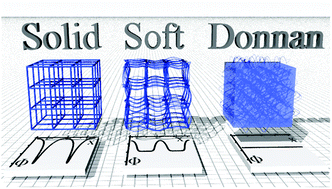Soft nanofluidics governing minority ion exclusion in charged hydrogels†
Abstract
We investigate ionic partition of negatively charged molecular probes into also negatively charged, covalently crosslinked alginate hydrogels. The aim is to delimit the domain of validity of the major nanoelectrostatic models, and in particular to assess the influence of hydrogel chain mobility on ionic partition. We find that the widely used Gibbs–Donnan model greatly overestimates exclusion of the co-ion probes used. For low molecular weight probes, a much better fit is obtained by taking into account the electrostatics in the nanometric gel pores by means of the Poisson–Boltzmann framework; the fit is improved slightly when taking into account alginate chain mobility. For high molecular weight probes, we find it essential to take into account local gel deformation due to electrostatic repulsion between the flexible gel strands and the probe. This is achieved by combining Poisson–Boltzmann simulations with heterogeneous pore size distribution given by the Ogston model, or more simply and precisely, by applying a semi-empirical scaling law involving the ratio between Debye length and pore size.


 Please wait while we load your content...
Please wait while we load your content...